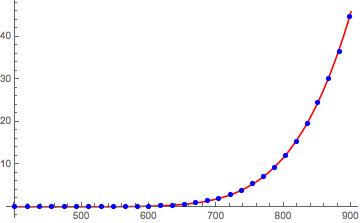I have some data and want to fit it to Planck's law for black body radiation. The problem is that Mathematica does not give me the correct coefficients.
When I evaluate
dati = Import["https://pastebin.com/raw/MGEzkeC3", "Table"];
h = 6.62607004*10^(-34);
c = 299792458;
kb = 1.38064852*10^(-23);
Planks[l_, T_, A_] := (1/A)*(((2*h*c^2)/l^5)*(1/(Exp[((h*c)/(l*kb*T))] - 1)));
fittesana2 = FindFit[dati, Planks[l, T, A], {T, A } , l];
Show[
Plot[fittesana2[l], {l, 400, 900}, PlotStyle -> Red, PlotRange -> All],
ListPlot[dati], Frame -> True]
Pfit = NonlinearModelFit[dati, Planks[l, T, A], {{A, 1*10^8}, {T, 1700}}, l];
Show[
Plot[Pfit[l], {l, 400, 900}, PlotStyle -> Red, PlotRange -> All],
ListPlot[dati], Frame -> True]
Normal[Pfit]
Pfit["ANOVATable"]
Pfit["ParameterTable"]
Pfit["FitCurvatureTable"]
I get
Sorry guys for forgetting to write down constants. And my data is only the part of Black Body radiation law. And unit of x-axis is nanometers(nm), and y-axis (uW/cm^2/nm).
Update: As suggested by @JimB, I changed my fitting function. I tried to use @JimB suggested function, but for me easier was different one, because I need to find out temperature (Te). Here is the code:
h = 6.62607004*10^(-34);
c = 299792458;
kb = 1.38064852*10^(-23);
b = 2*6.62607004*10^(-34)*299792458^2*Pi;
d = (6.62607004*10^(-34)*299792458)/(1.38064852*10^(-23));
dati = ImportString[Import["H2liesma.txt"], "Table"];
Plankulis[la_, Te_, G_, b_, d_] := (1/G)*(b/(la^5*(Exp[d/(la*Te)] - 1)));
Pfit3 = FindFit[dati,
Plankulis[la, Te, G, b, d], {G, 1*10^(9)}, { Te, 1500} , la];
Show[Plot[Pfit3[la], {la, 400, 900}, PlotStyle -> Red,
PlotRange -> All], ListPlot[dati], Frame -> True]
I get:
FindFit::nonopt: Options expected (instead of la) beyond position 4 in FindFit[{{400.035,-0.00759963},{400.409,0.0136996},{400.783,-0.000465753},{401.157,0.00636862},{401.531,0.0205706},{401.904,0.0257837},{402.278,0.0298773},{402.652,0.00226108},{403.025,0.0188769},{403.399,-0.0230916},{403.772,-0.00365794},{404.146,0.00856837},<<28>>,{414.961,-0.00272152},{415.333,-0.00222349},{415.706,-0.00943255},{416.078,-0.00921836},{416.45,0.00204648},{416.823,-0.0261218},{417.195,-0.00775242},{417.567,0.0140285},{417.939,-0.00992257},{418.311,-0.00711655},<<1408>>},<<24>>/<<1>>,{<<1>>},<<1>>,la]. An option must be a rule or a list of rules. >>
When I write analitical solution for my function:
b = 2*6.62607004*10^(-34)*299792458^2*Pi;
d = (6.62607004*10^(-34)*299792458)/(1.38064852*10^(-23));
Plankulis1[la_] := (1/G)*(b/(la^5*(Exp[d/(la*Te)] - 1)));
Te = 1500;
G = 1*10^(9);
Plankulis[G, b, la, d, Te]
Plot[Plankulis1[la], {la, 400*10^(-9),
700*10^(-8)}, {PlotRange -> Full}, Frame -> True]
I get out what I need.
What is it I am doing wrong? I did not really understood it in answers. Thank you.










FindFitmight get stuck in some local optimum. I suspect that your value forAmight need a nudge in the right direction. You can also try to fit the logarithm of your parameters (e.g., replaceA -> Exp[logA]in the formula), since that makes it easier for the fitting algorithm to cover a large range of magnitudes. $\endgroup$FindFit[]wrong: tryFindFit[dati, Plankulis[la, Te, G, b, d], {{G, 1*10^9}, {Te, 1500}}, la]. $\endgroup$